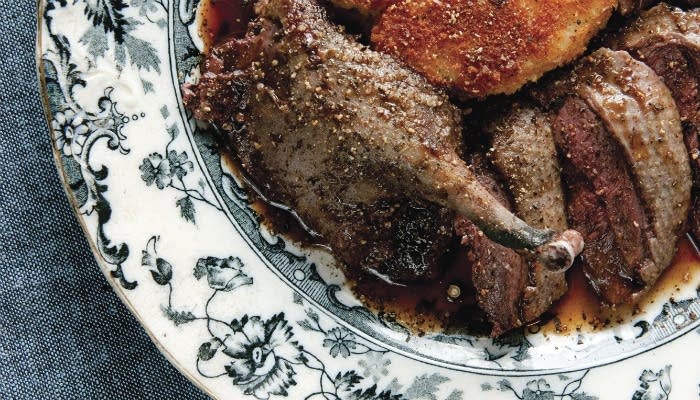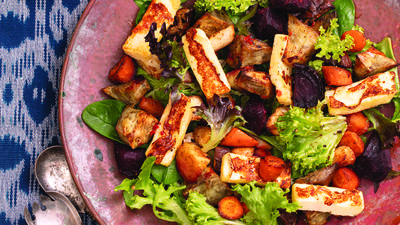
Difficulty: **
You can roast a whole domesticated duck or goose with perfect success. The key to getting medium-rare breast meat and tender fully done legs and wings is to take the bird apart midstream. You roast the whole bird for a while, then you slice off the breast meat and finish it in a pan once the legs are done. It's really a more civilized way to eat. And because you are cooking at a relatively low temperature, you won't smoke up your kitchen.
Since the ducks and geese you buy in the store come with giblets, I've also included a recipe for traditional holiday gravy. If you don't want to use your giblets for gravy, make the German giblet soup Ganseklein with them.
This recipe is specifically designed for fat domesticated ducks and geese. Try this method with a wild bird only if it is large and very fatty, such as a big mallard or pintail duck or a specklebelly goose.
You will get lots of extra goose fat from this. Save it. Duck fat and goose fat are God's gift to potatoes, plus they are a spectacular medium for cooking winter greens such as kale, spinach, or chard.
Ingredients
 Duck, Duck, Goose
Duck, Duck, Goose
1 domesticated duck or goose
1 lemon, halved
Kosher salt and freshly ground pepper
1/2 yellow onion, chopped
1 head garlic
1 tablespoon duck or goose fat or unsalted butter
Gravy:
Giblets (except liver), neck, and wing tips from duck or goose
1 tablespoon duck or goose fat or unsalted butter
1/2 cup chopped onion
2 tablespoons all-purpose flour
1/2 cup Madeira or sherry
2 cups Basic Duck Stock or chicken stock
1 teaspoon dried thyme
Instructions
If the duck or goose has been refrigerated, bring it to room temperature before cooking. Keep it in its plastic wrapping resting in a pan until you are ready to cook it, so that if the covering leaks for any reason, the juices will be confined to the pan. If the bird is frozen, you will need to thaw it in the refrigerator for at least 24 hours; geese will need a full 48 hours.
Remove the neck and giblets (heart, gizzard, liver) and reserve all but the liver for the gravy; use the liver for another recipe. You want to reserve the last two joints of the wings for the gravy, as well. To do this, use kitchen shears--or a small, sharp knife--and cut across the side of the joint, severing the tendons. Bend the joint backward to break it, and cut the remaining skin and tendons. You should not need to cut bone at all. Next, cut off the neck skin about 1/2 inch away from the body.
To remove excess fat, grasp the fat inside the body cavity, pull it free, and put it in a bowl. Now slice off the wide belly flaps covering the body cavity, and then remove the tail, also called the pope's nose. To ensure crisp skin, pierce the skin all over with a clean needle or the tip of a sharp knife, positioning the tool at an angle so that you are piercing just the skin and not the meat.
Preheat the oven to 325°F. Have ready a roasting pan with a rack. Rub the duck or goose all over with the cut sides of the lemon. Use both halves to coat it thoroughly. Put the halves inside the cavity. Sprinkle salt liberally all over the bird. Use more salt than you think you need; it helps crisp the skin and adds a lot of flavor. Slice off the top 1/2 inch or so of the garlic head, and place the head inside the cavity. Place the bird, breast side up, on the rack in the pan and slide the pan into the oven.
When the bird goes in the oven, start the gravy. Chop the giblets, wing tips, and neck and put them in a large pan with the goose fat. Sprinkle with salt, place over medium-high heat, and cook, stirring as needed to prevent scorching, until the pieces are browned. Add the onion and stir to combine. When the onion is slightly browned, sprinkle in the flour and again stir to combine. Cook over medium heat, stirring often, for 5 to 10 minutes, until the mixture smells nutty. Turn the heat to high and add the Madeira. Let the liquid boil furiously for a minute or two, then add the stock and stir to combine. Add the thyme, turn down the heat so the gravy is at a bare simmer, and leave to cook, stirring occasionally and checking every now and again that it is not cooking too fast.
After the bird has cooked for 25 minutes, spoon out some of the fat from the roasting pan; discard it or use it for roasting potatoes later. Test the temperature of the breast with an instant-read thermometer. For a smallish duck, the temperature should register between 130°F and 140°F. Large ducks and geese may need up to 45 minutes to get this warm. When the breast has reached this point, remove the bird from the oven but keep the oven on.
 More from Shaw: How to Carve Ducks and Geese
More from Shaw: How to Carve Ducks and Geese
Carve off the breasts and put them on a platter, skin side up. Tent the breasts with aluminum foil. Put the bird (minus the breasts) back into the oven and cook for another 45 minutes. Meanwhile, continue to watch the gravy. If it gets too thick, add a little water or stock.
After the additional 45 minutes have passed, probe the thickest part of the bird's thigh with the thermometer. It should register at least 165°F. If it is higher, that's fine, as the legs of waterfowl are very forgiving. If it is lower, keep roasting it.
Remove the garlic from the cavity. Once the legs hit their target temperature, remove the bird from the oven, tent it with foil, and set aside. Remove the garlic cloves from their skins, add to the gravy, and cook for 5 minutes. Fish out the neck and wing pieces and pick off any bits of meat and toss them into the gravy. Pour the gravy into a blender and blend until very smooth. You might have to do this in batches to avoid it spurting out of your blender. You want the gravy to be thick but not gloppy. If it is too thick, add water to thin to a good consistency. Return the gravy to the pan and put over very low heat. Simmer it if it is too thin. (Note: If you like chunky gravy, by all means skip the blender step.)
Heat a large sauté pan over medium-high heat and add the duck or goose fat. Meanwhile, lift the breasts, which should be a lovely pink on the meat side, and pat them dry. Pour any accumulated juices into the gravy.
When the fat is hot, place the breasts, skin side down, in the pan and sear the skin hard. You might need to press down on the breasts a little to get good contact. Check after 2 to 4 minutes. You want a rich brown. When the color is good, remove the breasts and immediately salt the skin. Set aside, skin side up. Move the pan off the heat.
Carve off the legs and wings of the bird. Get the sauté pan hot again and sear the skin surfaces of the legs and wings. While they are searing, slice the breast at an angle to ensure you get a good amount of skin with each slice. Salt the legs and wings and serve. You have worked hard to get a good sear on the skin, so put your lovely gravy underneath the meat or on the side, not on top of the skin. Be sure to save the bones from the carcass to make stock.
Reprinted with permission from Duck, Duck, Goose by Hank Shaw, copyright (c) 2013. Published by Ten Speed Press, a division of Random House, Inc. Photography (c) 2013 by Holly A. Heyser
Before you go...
Each week, The Splendid Table brings you stories that expand your world view, inspire you to try something new, and show how food connects us all. We rely on your generous support. For as little as $5 a month, you can have a lasting impact on The Splendid Table. And, when you donate, you’ll join a community of like-minded individuals who love good food, good conversation, and kitchen companionship. Show your love for The Splendid Table with a gift today.
Thank you for your support.
Donate today for as little as $5.00 a month. Your gift only takes a few minutes and has a lasting impact on The Splendid Table and you'll be welcomed into The Splendid Table Co-op.




